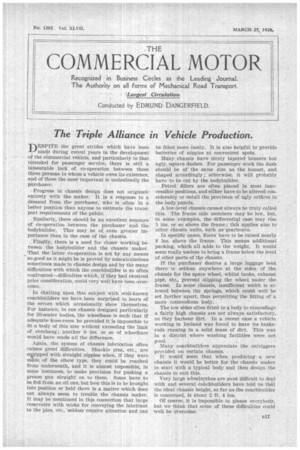The Triple Alliance in Vehicle Production.
Page 79

If you've noticed an error in this article please click here to report it so we can fix it.
-1--" ESPITE the great strides which have been made during recent years in the development of the commercial vehicle, and particularly in that intended for passenger service, there is still a lamentable lack of co-operation between those three persons to whom a vehicle owes its existence, and of these the most important is undoubtedly the purchaser.
Progress in chassis design does not originate entirely with the maker. It is a response to a demand from the purchaser, who is often in a better position than anyone to estimate the transport requirements of the public.
Similarly, there should be an excellent measure of co-operation between the purchaser ' and the bodybuilder. This may be of even greater importance than in the case of the chassis.
Finally, there is a need for closer working between the bodybuilder and the chassis maker. That the latter co-operation is not by any means so good as it might be is proved by miscalculations sometimes made in chassis design and by the many difficulties with which the coachbuilder is so often confronted—difficulties which, if they had received prior consideration, could very well have been over come. • In chatting upon this subject with Well-known coachbuilders we have been surprised to learn of the errors which occasionally show themselves. For instance, in one chassis designed particularly for 20-seater bodies, the wheelbase is such that if adequate knee-room be provided it is impossible to fit a body of this size without exceeding the limit of overhang ; another 9 ins, or so of wheelbase would have made all the difference.
Again, the system of chassis lubrication often causes great difficulties. Shackle pins, etc., are evipped with straight nipples when, if they were made of the elbow type, they could be reached from underneath, and it is almost impossible, in some instances, to make provision for pushing a grease gun straight on to them. Some have to be fed from an oil can, but how this is to be brought into position or held there is a matter which does not always seem to trouble the chassis maker. It may be mentioned in this connection that large reservoirs with wicks for conveying the lubricant to the pins, etc., seldom require attention and can be filled.more 6asily. It is also helpful to provide batteries of nipples at convenient spots.
Many chassis have nicely tapered bonnets but ugly, square dashes. For passenger work the dash should be of the same size as the bonnet, and shaped accordingly ; otherwise, it will probably have to be cut by the bodybuilder.
. Petrol fillers are often placed in most inaccessible positions, and either have to be altered considerably or entail the provision of ugly orifices in the body panels.
A low-level chassis cannot always be truly called this. The frame side Members may be low, but, in some examples, the differential case may rise 5 ins. or so above the frame ; this applies also to other chassis Units, such as gearboxes.
In specific eases, floors have to be raised nearly 8 ins, above the frame. This means additional packing, which all adds to the weight. It would seem really useless to bring a frame below the level of other parts of the chassis.
If the purchaser desires a large luggage boot there is seldom anywhere at the sides of the chassis for the spare wheel, whilst tanks, exhaust pipe, etc., prevent slipping the wheel under the frame. In some chassis, insufficient width is allowed between the springs, which could well be set farther apart, thus permitting the fitting of a more coMmodious body.
The low sides often fitted ton body to camouflage a fairly high chassis are nbt always satisfactory, as they harbour dirt. In a recent case a vehicle working in Ireland was found to have its brake rods running in a solid mass of dirt. This was in a district where washing facilities were not good.
Many coachbuilders appreciate the outriggers provided on certain chassis. .
It would seem that when producing a new chassis it would be better for the chassis maker to start with a typical body and then design the chassis to suit this.
Very.large wheelarches are most difficult to deal with and several coachbuilders have told us that the ideal chassis height, so far as the coachbuilder is concerned, is about 2 ft. 4 ins.
Of course, it is impossible to please everybody, but we think that some of these difficulties could well be oVercoine.' •




























































































































































































